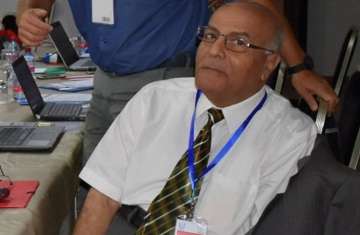عاجل
رانيا المشاط: مصر والسعودية تنفذان نموذجا ناجحا للتعاون الإقليمي بالربط الكهربائي
 توقيع اتفاقيات مشروع نقل غاز حقل "كرونوس" القبرصي إلى مصر
توقيع اتفاقيات مشروع نقل غاز حقل "كرونوس" القبرصي إلى مصر
 عاجل| روسيا: هناك مقاتلون أجانب على الجبهة في أوكرانيا وسندمّرهم
عاجل| روسيا: هناك مقاتلون أجانب على الجبهة في أوكرانيا وسندمّرهم
 «عفريت» نيتانياهو!
«عفريت» نيتانياهو!
 عاجل| السودان: الدعم السريع يرتكب عمليات قتل عنصري ممنهجة ضد المدنيين
عاجل| السودان: الدعم السريع يرتكب عمليات قتل عنصري ممنهجة ضد المدنيين
 بعد تقديم أوراق اعتماده لـ السيسي.. السفير البريطاني الجديد: أتطلع إلى تعميق تعاوننا
بعد تقديم أوراق اعتماده لـ السيسي.. السفير البريطاني الجديد: أتطلع إلى تعميق تعاوننا
 الحكومة المصرية تستعرض الفرص الاستثمارية المُقرر طرحها خلال المرحلة المقبلة
الحكومة المصرية تستعرض الفرص الاستثمارية المُقرر طرحها خلال المرحلة المقبلة
 عاجل| السودان: 47 قتيلا في مجازر للدعم السريع.. واشتباكات عنيفة مع الجيش
عاجل| السودان: 47 قتيلا في مجازر للدعم السريع.. واشتباكات عنيفة مع الجيش

 توقيع اتفاقيات مشروع نقل غاز حقل "كرونوس" القبرصي إلى مصر
توقيع اتفاقيات مشروع نقل غاز حقل "كرونوس" القبرصي إلى مصر
 عاجل| روسيا: هناك مقاتلون أجانب على الجبهة في أوكرانيا وسندمّرهم
عاجل| روسيا: هناك مقاتلون أجانب على الجبهة في أوكرانيا وسندمّرهم
 «عفريت» نيتانياهو!
«عفريت» نيتانياهو!
 عاجل| السودان: الدعم السريع يرتكب عمليات قتل عنصري ممنهجة ضد المدنيين
عاجل| السودان: الدعم السريع يرتكب عمليات قتل عنصري ممنهجة ضد المدنيين
 بعد تقديم أوراق اعتماده لـ السيسي.. السفير البريطاني الجديد: أتطلع إلى تعميق تعاوننا
بعد تقديم أوراق اعتماده لـ السيسي.. السفير البريطاني الجديد: أتطلع إلى تعميق تعاوننا
 الحكومة المصرية تستعرض الفرص الاستثمارية المُقرر طرحها خلال المرحلة المقبلة
الحكومة المصرية تستعرض الفرص الاستثمارية المُقرر طرحها خلال المرحلة المقبلة
 عاجل| السودان: 47 قتيلا في مجازر للدعم السريع.. واشتباكات عنيفة مع الجيش
عاجل| السودان: 47 قتيلا في مجازر للدعم السريع.. واشتباكات عنيفة مع الجيش











التعليقات